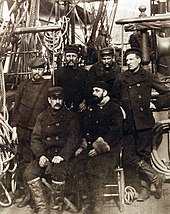William E. Chandler
[3] Chandler, who continued to advocate civil rights following the end of Reconstruction, criticized the policies of President Rutherford B. Hayes, whose actions pertaining to the South he viewed as too lenient.
In 1874, after his first wife's death, Chandler resumed his romance with Lucy Hale, who had been secretly betrothed in 1865 to John Wilkes Booth, Abraham Lincoln's assassin.
[3] Among intraparty disputes on civil rights between the Radical and "Conservative" factions, Chandler stated:[12] I notice, that everyone who goes South, whether Radical or Conservative, comes back confirmed in his previous opinion.During Reconstruction, Chandler expressed pessimism about Republican efforts to safeguard Southern blacks from Democratic terrorism, viewing a demise of military protection as inevitable.
We are bound to be overwhelmed by the new rebel combinations in every southern state.On April 2, 1868, Chandler testified in the impeachment trial of President Andrew Johnson, having been called as a witness by the prosecution.
[14] Amidst controversies that ensued in the wake of the 1876 United States presidential election, Chandler aided Republican efforts to ensure an ultimate victory for Rutherford B. Hayes over Samuel J. Tilden.
[5] One ship, the USS Chicago, was still built with antiquated boilers over brick furnaces and furnished with sailing equipment, in addition to steam power.
[5] Although Chandler was charged with favoritism in the construction of the USS Dolphin, he established the precedent for a modern navy made of steel ships.
[5] By 1883, the ill-fated crew of the U.S. Army 1881 Greely scientific polar expedition was stranded at Fort Conger on Lady Franklin Bay.
[16] The first, on July 8, 1882, led by William Beebe, on the private steamship Neptune, left St. John's, but was trapped by ice and forced to turn around.
On June 29, 1883, the second left St. John's, with two ships, the Proteus, commanded by First Lieutenant Ernest Garlington, U.S. 7th Cavalry, and the steam gunboat USS Yantic.
[16] On September 1, 1883, with no relief in sight, Greely and his party left the safety of Fort Conger on small boats, over rough ice-capped waters, and made a permanent base, Camp Clay, at Cape Sabine, on Pim Island, off the eastern shores of the Johan Peninsula, Ellesmere Island, where rations had been placed by the British a few years earlier.
Chandler spared no expense in the rescue effort and had purchased one of the finest sealers afloat, the USS Bear, from Scottish owner Walter Grieve, for $100,000.
[17][16] Chandler vigorously demanded that all of his subordinates in the Naval Department be committed to the relief of the Greely expedition and he drew support from Navy officers.
[16] As a Republican, he was elected to the United States Senate to fill the vacancy caused by the death of Austin F. Pike and served from June 14, 1887, to March 3, 1889.
[18] Among the solutions Chandler proposed for addressing the "evils which have been made apparent by the vast increase, within recent years, of degraded immigrants from Italy, Turkey, Hungary, Poland and Russia proper" were the addition of an educational requirement and property qualification for all persons or families seeking to emigrate to the United States.
In 1907, Chandler served as the lead counsel during the Next Friends Suit, a legal challenge over the estate of Mary Baker Eddy, the leader of the Christian Science church.
While aboard the cruiser USS Louisville, he was killed in action by a Japanese kamikaze aircraft during the Battle of Lingayen Gulf in January 1945.




